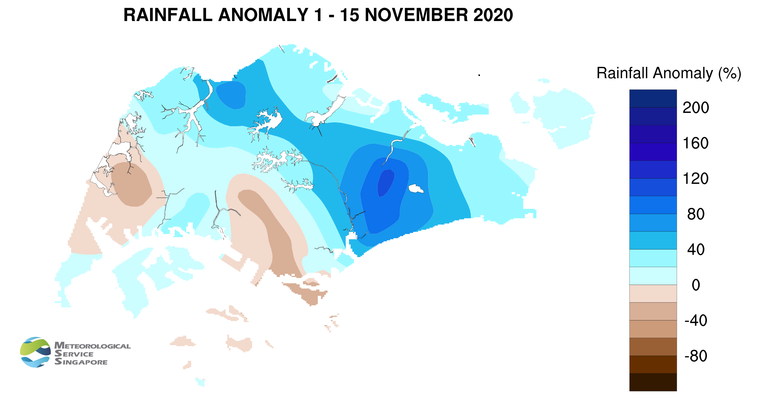Fortnightly Weather Outlook for 16 – 30 November 2020
Singapore, 16 November 2020 – Inter-monsoon conditions with low level winds that are light and variable in direction have been prevailing over Singapore since the start of November 2020. In the second half of November 2020, the low-level winds are forecast to gradually strengthen and shift to blow from the northeast or northwest around the end of the month. This change in monsoonal winds signal the start of the Northeast Monsoon season, and is expected to extend into March 2021.
2 With the monsoon rain band forecast to continue to lie over the equatorial Southeast Asia region for the rest of the month, the second half of November 2020 is expected to be as wet as the first half of the month. During this period, short-duration moderate to heavy thundery showers are expected over parts of the island in the afternoon on most days. There could be a few days where the showers may extend into the evening. On one or two days where the winds are forecast to blow from the southwest or west, the passage of Sumatra squalls is expected to bring widespread thundery showers and gusty winds over the island between the predawn and early morning. The rainfall for November 2020 is likely to be above average over most parts of Singapore.
3 The daily temperature on most days in the second fortnight of November 2020 is forecast to range between 24°C and 34°C. Although showers are expected on most days of the fortnight, the daily maximum temperature could still reach a high of around 35°C on one or two days.
4 For updates of the daily weather and haze situation, please visit the MSS website (https://www.weather.gov.sg), NEA website (www.nea.gov.sg), or download the myENV app, MSS’ Weather@SG app, and the haze microsite (www.haze.gov.sg).
REVIEW (1 – 15 November 2020)
5 In the first fortnight of November 2020, inter-monsoon conditions prevailed over Singapore, and the monsoon rain band was located over the equatorial South China Sea region.
6 During the first half of November 2020, with winds that were light and variable in direction and strong solar heating of land areas, moderate to heavy thundery showers fell over the island on many days. On 2 Nov 2020, flash floods were reported over several areas in the afternoon following a heavy downpour over many parts of the island. The intense thundery showers that day was a result of strong solar heating of land areas coupled with convergence of winds over Singapore and the surrounding vicinity. The highest daily rainfall recorded on 2 November 2020 was 134.2mm at Paya Lebar. This was the highest total rainfall in a day for the first half of November 2020.
7 In the first two weeks of November 2020, despite the wet conditions, there were a few warm days where the daily maximum temperature exceeded 34°C. During the period, the daily temperature ranged between 22.5°C and 34.9°C. The highest daily maximum temperature of 34.9°C was recorded on 5 and 12 November 2020 at Clementi and Paya Lebar respectively. The daily minimum temperature on most days ranged between 23°C and 24°C, and the lowest daily minimum temperature of 22.5°C was recorded on 2 November 2020 at Newton.
8 Most parts of the island received average to above-average rainfall in the first half of November 2020. The highest anomaly of 114% above average was recorded at Paya Lebar. The anomaly was lowest at Jurong at 40% below average.
CLIMATE STATION STATISTICS
Long-term Statistics for November
(Climatological reference period: 1981 – 2010)
| Average daily maximum temperature | 31.1 °C |
| Average daily minimum temperature | 24.3 °C |
| Average monthly temperature | 27 °C |
| Average rainfall | 258.5 mm |
| Average number of rain days | 18 |
Historical Extremes for November
(Rainfall since 1869 and temperature since 1929)
| Highest monthly mean daily maximum temperature: | 32.1 °C (2015) |
| Lowest monthly mean daily minimum temperature: | 22.4 °C (1933) |
| Highest monthly rainfall ever recorded: | 512.5 mm (1874) |
| Lowest monthly rainfall ever recorded: | 53.5 mm (1981) |

